Ogini O. O.1, Ofodile M. C.2, Odusanmi D. O.3, Taiwo A. M.4
1Educational Foundations Department, Babcock University, Ilishan-Remo, Nigeria
2Counseling Unit, Federal University of Agriculture, Abeokuta, Nigeria
3Voluntary Counseling and Testing unit, Federal University of Agriculture, Abeokuta, Nigeria
4Department of Environmental Management & Toxicology, Federal University of Agriculture, Abeokuta, Nigeria
Correspondence to: Taiwo A. M., Department of Environmental Management & Toxicology, Federal University of Agriculture, Abeokuta, Nigeria.
| Email: |  |
Copyright © 2015 Scientific & Academic Publishing. All Rights Reserved.
This work is licensed under the Creative Commons Attribution International License (CC BY).
http://creativecommons.org/licenses/by/4.0/

Abstract
The acquisition of knowledge and accessibility to information is essentially relevant to Voluntary Counseling and Testing (VCT) in any developing country. VCTs are increasingly important in global response to Human Immunodeficiency Virus/Acquired Immune Deficiency Syndrome HIV/AIDS. This study was carried out between February and June 2014, to ascertain the awareness and response of University students to HIV/AIDS Voluntary Counseling and Testing. A total of four hundred and sixty four students were interviewed with the aid of structured questionnaire. Data were analyzed for simple descriptive (mean and mode) and inferential (Chi square) statistics using the Statistical Package for Social Sciences (SPSS) for Windows. Results revealed that 52.2% of the respondents were females while 47.8% were males. Most respondents were between ages 20-24 (70.5%) and single (90.8%). A greater number of the respondents (83%) disagreed with the notion that HIV/AIDS can be contacted by sharing toilet facilities while 91% and 94.4% identified unprotected sex and the re-use of sharp objects used by HIV/AIDS patients as means of contracting HIV. The study on the level of awareness of HIV/AIDS revealed an appreciable level of awareness (91.1%). A large number of the respondents (77.6%) claimed that although they were aware of the VCT centre of the University but had never visited it. The study showed that there existed a significant relationship (p < 0.05) between the respondents’ age, sex, marital status, sexual information and perception, knowledge, attitudes and awareness of HIV/AIDS. This study recommends that social network platforms, ‘edu-tainment’, role models stories, discussion forums, behavior modifications, radio and drama would bring a decline in the transmission of the Virus within the University campus and increase students’ patronage of the VCT centre of the University.
Keywords:
Awareness, HIV/AIDS, Voluntary Counseling Testing, Students
Cite this paper: Ogini O. O., Ofodile M. C., Odusanmi D. O., Taiwo A. M., Awareness and Response to Human Immunodeficiency Virus / Acquired Immune Deficiency Syndrome (HIV/AIDS) among University Students in Abeokuta, Nigeria, Public Health Research, Vol. 5 No. 6, 2015, pp. 192-197. doi: 10.5923/j.phr.20150506.04.
1. Introduction
The threat of HIV continues to be one of the most dreaded health challenges in the world since 1980s (Whiteside, 2001). The global AIDS response revealed that the national meridian HIV prevalence infection in Nigeria as 4.1% (Akodu, 2014). Many published studies have revealed that many higher education institutionshabour a large number of young adults at their peak years of sexual activity and invariably become potential breeding grounds for HIV infections (Ebeniro, 2010; Onyene et al., 2010; Tenibiaje, 2011; Madebwe et al., 2012).Several cases of HIV infection had been reported based on socio-economic characteristics of people. Magnus and Gbakeji (2009) and Akodu (2014) opined that prevalence of HIV/AIDS is high among social groups such as students, artisans, prostitutes, drug addicts and young lads mostly between the ages of 20 and 24 years. This may be due to the high rate of pre-marital sexual activity engaged in tertiary institution campuses coupled with other negative acts such as drug addition, cultism and excessive consumption of alcoholic drinks (Wairimu, 2013). Also, the issues of dating and mate – seeking behaviours of Nigerian youths are rapidly changing due to concept of modernization and globalization (Arogundade and Faloore, 2012).Several methods have been put in place to ameliorate the risk of contracting HIV/AIDS among undergraduates, one of which is Voluntary Counseling and Testing (VCT). VCT is the process by which an individual undergoes counseling enabling him or her to make an informed choice about being tested for HIV (Tenibiaje, 2011; Asante, 2013). HIV/AIDS counseling is provided by trained counselors, though health workers and caregivers are often in a position to provide necessary counseling, advice and support (Abdulraheem, 2004). The VCT unit of the Federal University of Agriculture, Abeokuta, Ogun State, Nigeria has being in existence since 2005. It provides out-patient consultations to students, staff and their dependants towards preventing HIV/AIDS. Therefore, an appraisal of the knowledge of University students towards HIV counseling and testing is important and may have positive long-term consequences on prevention and control of HIV among that vulnerable age group. The objective of this study is to evaluate awareness and response of the Federal University of Agriculture, Abeokuta students to HIV/AIDS Voluntary Counseling and Testing (VCT).
2. Methodology
The study was carried out in the Federal University of Agriculture, Abeokuta (FUNAAB) between February and June 2014. Abeokuta is the capital of Ogun State and the traditional home of Egbas. Abeokuta lies on latitude 7°15′N and longitude 3°25E. The town is about 80 km South-West of Ibadan, the Oyo State capital and 106km North of Lagos, former capital city of Nigeria. It is stratified into Abeokuta North, Abeokuta South and parts of Odeda, and Owode Egba Local Government Areas.The questionnaire used for this study were validated after which they were administered using a stratified sampling technique on students selected from eight Colleges of the University (58 students per College) making a total of 464 respondents. Also, the following null hypotheses were propounded. (i) There is no significant relationship between the respondents (students) and their knowledge about the HIV Virus.(ii) There is no significant relationship between the respondents (students) and their perception about the HIV infection. (iii) There is nosignificant relationship between the respondents (students) and their attitudes towards HIV Voluntary Counseling, Testing and awareness.Data collected from the questionnaire administration were analyzed for simple descriptive (mean and mode) and inferential (Chi square) statistics using the Statistical Package for Social Sciences (SPSS) for Windows (version 16.0) Results were presented in tables and figures.
3. Results and Discussion
Table 1 showed the age, sex, marital status and sexual information of the respondents. Majority of the respondents 327(70.5%) were between the age group 20-24 years while a small fraction 55(11.9%) were between the age class15-19 years. This is indicated that the respondents were adults who were prone to the risk of contracting HIV and other sexual related diseases. This observation is in line with the studies which reported that youths at age of 15-25 years are more susceptible to HIV infection (Tenibiaje, 2011; Akodu 2014). Gender disparity indicated that more than half of the respondents (52.2%) were females. Also, 90.8% were single while 7.7% were married. This observation corroborates the findings of Adekunle and Akinlemibola (2008).Table 1. Age, sex, marital status and sexual information of the respondents
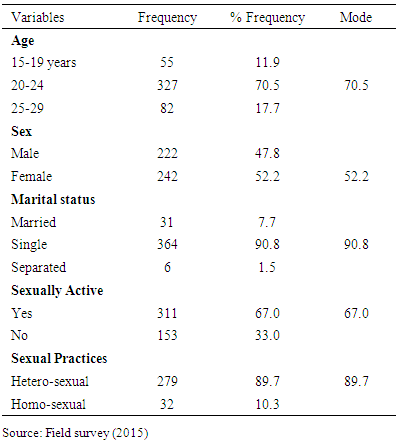 |
| |
|
Results of this study on the sexual activeness of the respondents indicated that 67.0% were sexually active. Two hundred and fifty three (279) respondents (89.7%) engaged in hetero-sexual practices while 10.3% involved in homosexual practices. The growing numbers of homosexual students in the University might be related directly to the type of secondary school attended. It has been observed that students who attended same sex school may resort to homosexuality to satisfy their sexual urge (Adeyanju, 2012). Another reason for the homosexual behaviours of these students may be linked to watching of pornographic videos that have homosexual contents.Table 2 presents the knowledge and perception of the respondents about HIV/AIDS infection. Majority of the respondents (83.1%) disagreed that HIV/AIDS can be contacted by sharing toilets. Thirty-two percent (32.0%) reported that people who live immoral lives are more vulnerable to HIV Virus while 22.4% of the respondents disagreed with this position. Also, 80.3% of respondents were of the notion that HIV/AIDS positive individuals cannot be recognized through physical appearance. Also, 67.9% recommended a healthy lifestyle for people living with HIV/AIDS. In the same trend, 42.4% of respondents indicated that women are more prone to contacting HIV/AIDS than men and that proper use of condoms is one of the preventive measures against the spread of HIV/AIDS. Majority of the respondents (91.1%) had opined that HIV/AIDS can be contacted through unprotected sex, 94.4% claimed unprotected sex and the re-use of sharp object already used by HIV/AIDS patients could be means of contracting HIV/AIDS. As high as 91.8% of the interviewed students agreed that awareness of one’s partner’s HIV/AIDS status before engaging in sex is very important. Most students (88.4%) disagreed that HIV/AIDS does not exist. In the same vein, 91.1% disagreed that only poor people can contact HIV/AIDS. Similarly, 83.1% of the respondents disagreed that sharing toilets can be a route to contacting HIV/AIDS virus.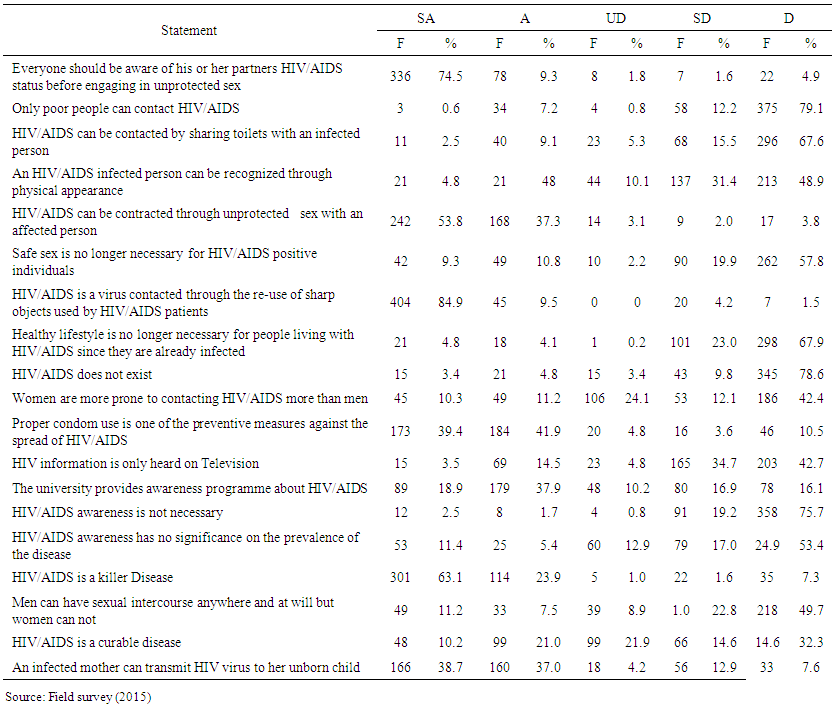 | Table 2. Knowledge and perception of respondents about HIV/AID Virus |
Over 80% of respondents (80.3%) agreed that an HIV infected individual cannot be recognized through physical appearance while 81.3% consented that proper use of condoms is a preventive measure to curtail the spread of HIV/AIDS. These positions by the respondents under this study clearly indicated that the knowledge of HIV/AIDS infection was very high. The majority of the students have tangible knowledge and high perception about facts and fictions of HIV/AIDS. The result of this study is in line with those found in Bezuidenhout and Summer (2007) and Ebeniro (2010) on the studies conducted on University students knowledge of HIV/AIDS were found to be high. On the issue of safe sex, more than seventy percent (77.8%) of the respondents surveyed in this study were supported that safe sex is not necessary for HIV positive individuals (Table 2) since they have already been infected with the Virus. This might be seen as a display of ignorance and as a significant factor that could be responsible for the spread of HIV among the higher institution students in Nigeria (Emeka-Nwabunnia et al., 2014). The research work of Huisamer (2010) revealed that safe sex is still necessary for individuals living with HIV despite the fact that they were already infected. Also, 90.9% of the respondents claimed that a healthy lifestyle is necessary for people living with the HIV/AIDS. The HIV/AIDS awareness through television programmes appears declining as 70.7% of the respondents were unable to obtain information on HIV/AIDS on television. The students in this category were however, aware of several governmental and non-governmental organizations placing advertisements on HIV/AIDS awareness and preventive measures through several communication strategies. The study of Asante (2013) involving undergraduates students in Accra, Ghana showed that 83% of the respondents received information about HIV/AIDS from the television.Table 3 shows the students’ attitude towards HIV/AIDS testing and counseling. Since public awareness on HIV/AIDS through television jingles appears to be less effective in disseminating the knowledge of the Virus to the youths, especially the students under this study. It is therefore essential to find effective means of informing the students about HIV/AIDS while on campus. This might be appropriately carried out through the University’s VCT centre. In this study, 82% respondents claimed that it was not necessary to subject oneself to voluntary HIV/AIDS counseling and testing. However, 82.7% respondents supported that HIV Counseling and Testing are necessary for every individual. This result was similar to the study conducted by Huisamer (2010) on students of the University of Stellenbosch, South Africa, where two-third of the students agreed that counseling is necessary for every individual before or after HIV/AIDS testing. Knowing one’s HIV status has been said to prevent AIDS and also the spread of the Virus (Mascolini, 2004).Table 3. Students’ attitude towards HIV/AIDS testing and counseling
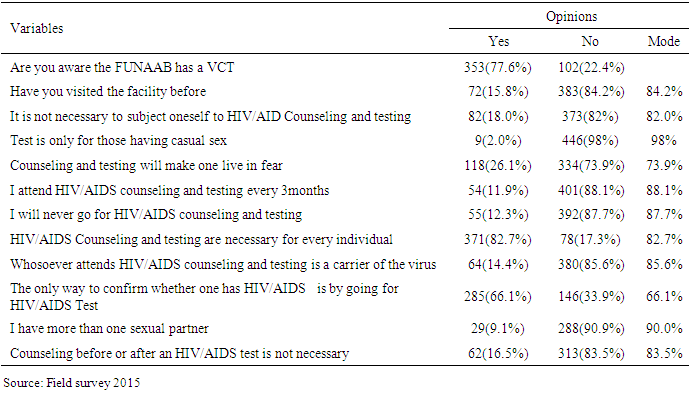 |
| |
|
The level of awareness about HIV/AIDS was moderate at Federal University of Agriculture, Abeokuta as 56.8% of the students confirmed the HIV/AIDS awareness programmes on campus. A huge fraction of the students (77.6%) were aware that the University has a VCT centre. It very unfortunate that only 15.8% of the total students surveyed had visited the facility despite their awareness of the Unit. The figures on the awareness of HIV counseling and testing were lower than those reported by Akodu (2014) among the undergraduate students of University of Lagos. Similarly, Madebwe et al (2012) recorded that 93% (male) and 96% (female) have heard about VCT while only 28% (male) and 27% (female) student respectively have undergone voluntary counseling and testing for HIV/AIDS in the VCT.This study showed that there existed a significant relationship (p<0.05) between age, sex, marital status, sexual information of the respondents and their knowledge about HIV/AIDS (Table 4). It shows that the spread of HIV may not due to lack of knowledge and awareness about the spread of the Virus. Most of the students surveyed were aware of HIV/AIDS and its negative effects. Table 5 shows the relationship between respondents’ age, sex, marital status, sexual information and their perception towards HIV/AIDS Testing, counseling and awareness. A significant relationship (p<0.05) was established between the respondents and their perception towards HIV/AIDS Testing, counseling and awareness. As stated earlier, the students have strong perception about HIV/AIDS Testing, counseling and awareness but were indisposed to visiting the VCT centre.Table 4. Chi-square showing relationship between respondents’ age, sex, marital status, sexual information, and their knowledge about HIV/AIDS
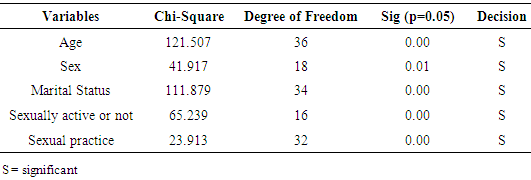 |
| |
|
Table 5. Chi-Square showing relationship between respondents’ age, sex, marital status, sexual information, and their perception towards HIV/AIDS Testing, counseling and awareness
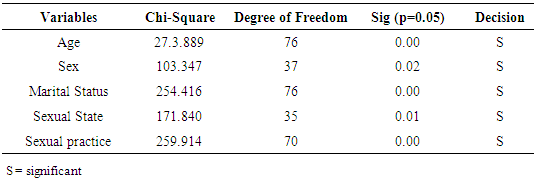 |
| |
|
A significant (p<0.05) relationship was also found between respondents’ age, sex, marital status, sexual information and their attitude towards HIV/AIDS Testing, counseling and awareness (Table 6). In this study, the significant relationship established between the respondents’ age, sex, marital status, sexual information and perception, knowledge, attitudes and awareness of HIV/AIDS therefore means that the null hypotheses set for the study may be rejected. The respondents showed positive response to HIV/AIDS awareness but their attitudes towards subjecting themselves screening through VCT centre is very poor. This might be seen as a display of ignorance and possible spread of the Virus (Williams, 2011).Table 6. Chi-Square showing relationship between respondents’ age, sex, marital status, sexual information, and their attitude towards HIV/AIDS Testing, counseling and awareness
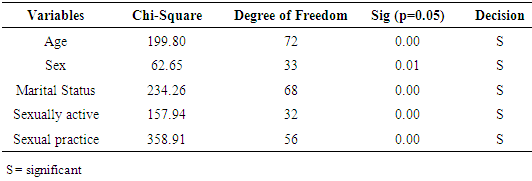 |
| |
|
4. Conclusions and Recommendations
Based on the result of this finding, much may still need to be done in ensuring adequate HIV/AIDS awareness on campus as 84.2% of respondents surveyed for this research revealed that they have not visited the VCT for counseling and testing in three (3) months. In order to boost HIV/AIDS awareness and prevention information on campus, it may be necessary to offer HIV/AIDS as a compulsory ‘General Studies’ course at the undergraduate level. Information on issues relating to HIV/AIDS can be passed to students via social network platforms (Facebook, twitter, mixit, tugo, whatsapp, twoo), which are highly recommended rather than face –to-face interaction. Universities need to invigorate HIV/AIDS prevention initiatives and make them more visible by imploring methods such as radio, drama, television and films.
References
| [1] | Adeyanju BI (2012). Knowledge and attitude of undergraduate students towards homosexuality and its implication on social adjustment (A study of Caritas University, Amorji-Nike, Emene) Enugu State. A BSc. Project of Caritas University, Amorji-Nike, Emene) Enugu State. |
| [2] | Adekunle VAJ and Akinlemibola O (2008). Effect of deforestation on climate change and global warming in Nigeria. In: Popoola, L. (ed.). Proceedings of the 32nd Annual Conference of Forestry Association of Nigeria (FAN) held in Umuahia, Aba State, Nigeria between 20th and 24th October, 2008. Pp. 170-182. |
| [3] | Abdulraheem IS (2004). Communication and counselling needs of patients with HIV/ AIDS: a public health practitioner’s perspective. Nigerian J. Guidance Counsel. 90 103-120 |
| [4] | Akodu SO (2014). Awareness and knowledge of HIV counseling and Testing among undergraduate university students in Lagos, Nigeria. Int. J.Tropical Disease Health. 4(9): 896-904. |
| [5] | Arogundade OT and Faloore OO (2012).HIV/AIDS Awareness as a predictor of university students’ dating behavior in South-Western Nigeria. Int. J. Psychol. Behavioral Sci.2 (1): 9-14. |
| [6] | Asante O (2013). HIV/AIDS knowledge and uptake of HIV counseling and testing among undergraduates private university students in Accra, Ghana. Reprod. Health. 10:17. |
| [7] | Bezuidenhout S and Summers RS (2007). HIV/AIDS awareness among first year pharmacy students and the role of the university. TD: J. Transdiscipl. Res. Southern Africa. 3(2): 305-318. |
| [8] | Ebeniro CD (2010). Knowledge and beliefs about hiv / aids among male and female students of Nigerian universities. J. Comp. Res. Anthropol.Sociol.1 (1): 121-131. |
| [9] | Emeka-Nwabunnia I, Ibeh BO and Ogbulie TE (2014). High HIV sero-prevalence among students of institutions of higher education in Southeast Nigeria. Asian Pac. J. Trop. Dis., 4(2): 159-165. |
| [10] | Fasakin JO and Olorewaju A (2004). The Epidemiology of HIV/AIDS in Africa across Regional Demographic Analysis. J. Urban Environ. Res. 2(1): 69. |
| [11] | Huisamer ZP (2010). HIV/AIDS knowledge, awareness and perception of undergraduate first-year students at the Cape Institute for Agricultural Training: higher education and training (Doctoral dissertation, Stellenbosch: University of Stellenbosch). |
| [12] | Madebwe V, Madebiwe C, Pazvakavamira L, and Kudakwashe CR (2012). Taking the Test: Voluntary Counseling and Testing (VCT) among Midland State University students. Education Res. J. 2(1): 7-13. |
| [13] | Magnus OO and Gbakeji OJ (2009). Analysis awareness of HIV/AIDS amongst students of tertiary institutions in Edo State, Nigeria. Ethno- Med. 3(2): 153-158. |
| [14] | Mascolini M (2004). Why people with HIV still die-and why they don't have to. IAPAC Month. 10(3), 78-98. |
| [15] | OnyeneV, UzokaN, Ikonta N and Bakare TV (2010). Tertiary institution learners’ HIV/AIDS sensitizationtool(s) receptivity: Implications for sustainable democracy in Nigeria. J. AIDS/ HIV Res. 2(4): 79-87. |
| [16] | Tenibiaje DJ (2011). Voluntary counseling and Testing as a panacea to HIV/AIDS Epidemic in Nigeria. J. Emerging Trend. Education. Res. Policy Stud. (JETERAPS). 2(4): 265- 270. |
| [17] | Wairimu MW (2013). Perceived factors influencing deviant behaviour among the youth in Njathaini Community, Nairobi, Kenya (Doctoral dissertation, Kenyatta University). |
| [18] | Whiteside A (2001). Demography and economics of HIV/AIDS. British Medic. Bullet. 58(1): 73-88. |
| [19] | Williams NC (2011). Knowledge of human immuno deficiency virus/acquired immuno deficiency syndrome (HIV/AIDS) among secondary school adolescents in Zaria metropolis: implications for counselling (Doctoral dissertation). |




 Abstract
Abstract Reference
Reference Full-Text PDF
Full-Text PDF Full-text HTML
Full-text HTML



